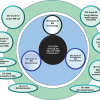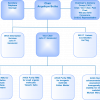Christopher Burgess and John Hammond
Burgess Analytical Consultancy Limited, ‘Rose Rae’, The Lendings, Startforth, Barnard Castle, Co. Durham, DL 12 9AB, UK
Starna Scientific Ltd, 52–54 Fowler Road, Hainault Business Park, Hainault, Essex, IG6 3UT, UK
In the last issue’s Quality Matters column (Vol. 23 No. 4), Peter Jenks wrote an interesting article detailing his view of the current regulatory environment, and the role of the analytical laboratory manager within it. This article offers an alternative perspective written by “practicing analytical chemists”; working within several of the standardisation bodies mentioned.
There is no fundamental difference in the way ISO develops standards compared with ASTM International, or any other standardisation body, for example, United States Pharmacopeia (USP). In all instances, these bodies use procedures designed to establish a draft document, based on technical input from experienced professional volunteers. This standard is then at least reviewed at the technical committee level before being passed as an “approved” document to the standards body for voting.
In the case of ISO, the Technical Committee (TC) is the driving force behind the creation of a new standard. ISO has eight of these which are tasked specifically with developing standards or guides. The International Commission on Illumination (CIE) is one, the Committee on Reference Materials (REMCO) is another, and both ISO/IEC 17025 and ISO/IEC 17043 are standards that have been produced by the third of these TCs, namely the Committee on Conformity Assessment (CASCO).
Formed in 1976, ISO/REMCO, has as its current Chair, Professor Hendrik Emons from IRMM. In addition, six of the nine Working Group convenors represent commercial laboratories producing reference materials. ISO/REMCO is responsible for Guides 30 to 35, and these are used primarily (as in the case of ISO Guide 34) by accreditation bodies to certify reference material producers only, they are not implemented or required to be audited against in commercial “fee for service” laboratories.
What is the role of traceable standards in assuring data quality?
The proper use of a reference standard is essential in providing confidence in analytical results and reportable values. Traceability of the reference standard is necessary. The extent of traceability will depend upon the intent and purpose of the testing. Some assays or calibrations require the use of Certified Reference Materials whilst others do not. It makes no analytical sense to force the use of CRMs if they are not required. However, the proper calibration of many analytical instruments can only be assured by reference to CRMs. The TPS57 document cited in the article states:
“Where reference materials are used for the purposes of calibration the traceability of the values assigned to the material shall be a consideration as to the reference materials’ fitness for purpose.”
In the UK, we are somewhat fortunate in that a Reference Material producer group (UKRMWG), consisting of major reference material manufacturers. also acts as BSI RMI/001—Reference Materials, a “mirror” organisation to ISO/REMCO, which holds the UK voting rights into ISO with respect to the input on REMCO documentation. This group also acts as a technical liaison to the United Kingdom Accreditation Service (UKAS).
In all consensus based decisions, there have to be checks and balances placed on the process to ensure that any dominant opinion is adequately reviewed and controlled, and these have to be in place right from the start of the process. This control is best achieved by taking time to establish the scope of the document in question. This scope not only includes the technical requirements but also consideration of the user community for which it is intended. It is very easy in any environment for an individual, usually the group leader, to champion the production of the draft standard, “in their own image”, and this must be matched by appropriate input from other members of the group to ensure that a consensus document is produced. Hopefully, the professionalism and ethos of the drafting individual will reflect the consensus view in their own image, and thereby minimise the necessity for control inputs.
It is a somewhat sad reflection that, in many instances, this situation arises simply because the aforesaid individual has been the only person willing to actually sit down and draft the document. Also, the membership of a given task group will probably reflect how urgent the requirement for the standard is perceived.
Once a document is produced, the draft standard is made available for comment/voting to a restricted audience, usually members of the appropriate sub-committee, and it is at this point that any significant changes should be made, and if necessary the draft re-balloted.
Finally, the document is released within the member organisation committee for public comment/voting, and at this stage the changes should only be relatively minor corrections. It is at this final voting stage that significant differences occur within the relative standards organisations, and this is where there is potential for problems to arise; given that a consensus vote only may simply be required to allow the passage of a draft document into print as a standard.
Where these standards organisations differ is in the procedural detail of just how these various stages are achieved, and being members of several does give in interesting perspective of the relative benefits or disadvantages of each system. We would not be as presumptuous as to act in judgement over the systems each organisation operates, however, clearly there are significant differences in the way standards are produced.
What beneficial effects, if any, has accreditation to ISO based standards achieved?
In our experience, the answer to this question is mixed and dependant on the laboratory culture. Sadly some laboratories regard compliance to the standard as an administrative and documentary burden/overhead necessary for business continuity. For them, the added value in terms of laboratory data integrity is minimal. However, for more enlightened laboratories, the standardised discipline of compliance is seen as framework for technical and managerial excellence. Auditability and transparency of analytical operations is a major factor in the establishment of laboratory data integrity. However, the understanding of and the commitment to the benefits of this type of quality assurance must be recognised and actively supported at all levels within the laboratory.
It has also been our experience over the last 20 years that the benefits of accreditation may be difficult to quantify in many areas, but they far outweigh the additional work required. “Data that is beyond fit for purpose” may prove invaluable additional analysis data when something goes wrong, as perfection cannot be maintained ad infinitum.
“The truth emerges more readily from error, than from confusion”—Francis Bacon, 1561–1626
However, when laboratories are experiencing problems with accreditation to ISO/IEC 17025 it may not be in the actual standard itself, but how it is being implemented in practice by the auditing accreditation body. This difference in interpretation was clearly demonstrated by statements made in discussions produced at a workshop on Commutability at the latest ISO/REMCO meeting in Delft, where obviously some accreditation bodies had determined as a “... where appropriate” clause, as a mandatory requirement in the revised ISO Guide 34:2009, 5.4.3. k. Clearly, there is a need to educate the accreditation bodies in the changes relating to the new issue of ISO Guide 34, a requirement which was also addressed by ISO/REMCO, by hosting a training seminar at the end of the meeting on this very topic.
What are the roles and responsibilities of the analytical laboratory manager regarding data quality integrity and security?
The final question is the most important. The largest contributor to laboratory testing variance is usually the human one. All analytical data are underpinned by the professional and technical competence and diligence of the analytical personnel. The role of the analytical laboratory manager is critical in delivering analytical outputs according to the customer’s requirements.
The Quality System is a framework to achieve this and is their servant not their master! Of course this will only be true if the managerial and technical culture in the organisation is appropriate.
Notes
Should you wish to contribute to the work of ISO/REMCO, please contact the Chair, detailing your specific area of expertise: Professor Dr Hendrik Emons, E-mail: [email protected]
Similarly, ASTM International committee E13, Chromatography, and Molecular Spectroscopy—or Committee E01 on Analytical Chemistry for Metals, Ores, and Related Materials (specifically sub-committee E01.20 Fundamental Practices) would be of interest to many readers of this article, and I’m sure these committees would welcome the expertise of new members.
The United Kingdom Reference Materials (UKRMWG) can be contacted via the Chairman: Dr Mike Sargent, E-mail: [email protected]










